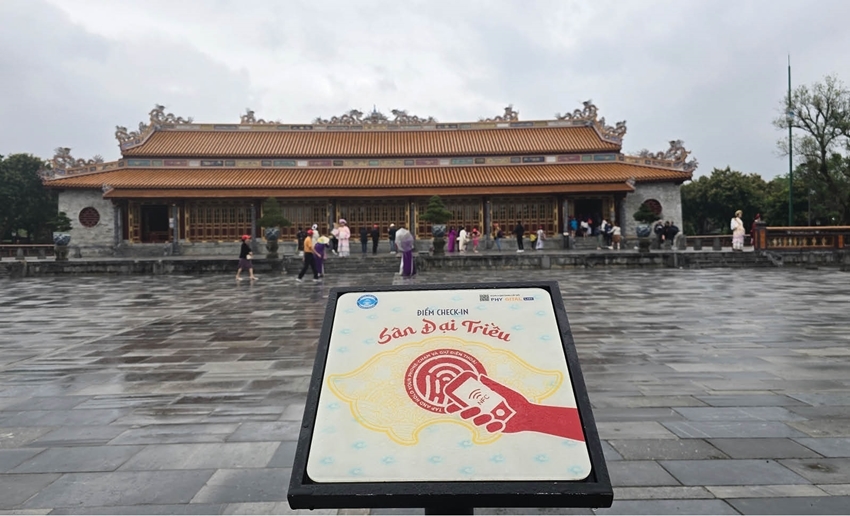Preservation for revival
As the only locality in Vietnam possessing 8 cultural heritages recognized by UNESCO, Hue Ancient capital carries within itself a massive treasure of tangible and intangible heritage. Since 1993, when Hue Monuments Complex was recognized by UNESCO as a World Cultural Heritage, Hue has built a long-term plan. The project of “Planning, conservation and promotion of the value of Hue Ancient Capital monuments” has been continuously adjusted, from the 1996-2010 phase, extended to 2020, and continuing implementation until 2030, with a vision to 2050.
On this journey, Hue Monuments Conservation Center plays a core role, with tireless efforts, both in researching and reconstructing, while constantly innovating to make heritage more vivid and closer to contemporary life.

Smart interactive TapQuest stations will cover the entire Hue Ancient Capital Monument Complex in 2025
In the intangible aspect, Hue continuously invests in-depth in conservation work. In 2022, the completion of a digital database on Hue Royal Court Opera created an important foundation for research and training work. Precious scripts, audio and video recordings were methodically systematized and digitized. Representative pieces of court music, opera, dance and traditional ceremonies were also collected and scientifically documented. Dozens of dossiers have been built, including two provincial-level dossiers on Hue’s court music and opera, demonstrating investment and determination to preserve ancestral treasures.
Particularly, the reconstruction of court ceremonies such as Nam Giao sacrifice, Xa Tac sacrifice, performance programs at Duyet Thi Duong Theater, Ngo Mon, Thai Hoa Palace courtyard... not only helps recreate the picture of ancient court culture but also brings the heritage closer to the public and tourists.
Director of Hue Monuments Conservation Center, Mr. Hoang Viet Trung, shared: “To date, the Center has collected 41 court music pieces, reconstructed and performed 17 Ca Chuong pieces in Nam Giao and Xa Tac sacrifices, built 22 scientific dossiers on court music, opera and dance, performed and promoted Hue court music in 9 countries. Nearly 15 Hue Festivals have continuously featured court performances, affirming Hue’s distinctive position in the flow of national culture. Additionally, the Center is researching to establish a project to digitize the court music notation system, restoring the Hue’s long ban method - a unique traditional notation technique.”
Heritage as development driver
Hue is gradually defining an economic model based on heritage values. Visitors to Hue not only visit the Imperial Citadel and royal tombs, but also live in heritage spaces: listening to court music, watching royal opera, enjoying cuisine, exploring craft villages... Heritage is activated to create livelihoods for people, enrich tourism products, and thereby spread cultural values.
Heritage conservation in the digital age cannot be done without technology. Hue is one of the pioneering localities in this field, with different projects applying digital technology to heritage conservation, display, and promotion. Since late 2022, Hue has implemented an electronic ticketing system at all monument sites, simplifying procedures, enhancing tourist experience, and facilitating cashless payments. Mobile navigation apps in the Imperial Citadel, automatic QR code commentary devices, wifi systems integrated with surveillance cameras, AI recognition software... have created an effective technology network supporting management and services.
Digitizing monuments with 360-degree technology and virtual reality (VR, XR) has created vivid exploration journeys. Locations such as Hue Imperial City, Tang Tho Pavilion, Temple of Literature... are integrated with digital data, 3D maps, telling cultural stories through each check-in journey. “This is not just an experience, but a way to revive memories with modern technology,” said Mr. Vo Quang Huy, Deputy Chief of the Office of Hue Monuments Conservation Center.
In the field of artifact conservation, Hue is pioneering the application of NFC chips and blockchain to identify, authenticate, and display artifacts in digital space. Nguyen Dynasty artifacts can be not only safely protected but also accessed from anywhere through the metaverse platform MuseeHue.vn - a “virtual museum” attracting young people. Through its blind box art toy collection model, the 'Imperial Archaeological Records' project has transformed Huế heritage symbols into cultural characters that appeal to Gen Z. Each product retells historical stories through visual language, fostering a new generation's appreciation for heritage.
Hue is also the first locality to deploy smart interactive TapQuest station technology at monument sites, allowing presence recording and suggesting appropriate experiences. It is expected that in 2025, 140 TapQuest stations will cover the entire Hue Ancient Capital Monument Complex.
“Heritage is a precious ‘soft resource’ that Hue possesses. Preserving it is not for storage, but to live with, to resonate with contemporary life rhythm, and to add strength for sustainable development,” said Mr. Hoang Viet Trung.